2013 General Election (GE) results shows that it was a Malaysian Tsunami and not a Chinese Tsunami that increased Pakatan Rakyat’s (PR) popular vote and number of parliament and state seats.
In an elaborate analysis by Dr. Ong Kian Ming, the newly elected member of Parliament for Serdang and DAP election strategist, he debunked the myth and rumour mongering by this minority elected Barisan Nasional (BN) federal government which has since then been uttering seditious and divisive statements ceaselessly.
________________________________________________________________________________________
Popular votes increased
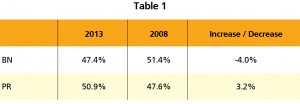 Pakatan’s popular vote in the whole of Malaysia increased from 47.6% in 2008 to 50.9% in 2013, representing a 3.2% increase in Pakatan’s support. BN’s popular vote decreased from 51.4% in 2008 to 47.4% in 2013, a 4.0% decrease. (refer Table 1)
Pakatan’s popular vote in the whole of Malaysia increased from 47.6% in 2008 to 50.9% in 2013, representing a 3.2% increase in Pakatan’s support. BN’s popular vote decreased from 51.4% in 2008 to 47.4% in 2013, a 4.0% decrease. (refer Table 1)
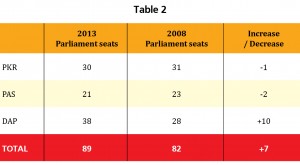 Calculations were made using only valid votes at the parliament level. From the analysis, Pakatan increased its share of parliament seats from 37% in 2008 to 40% in 2013 by winning at extra 7 parliament seats. (refer Table 2)
Calculations were made using only valid votes at the parliament level. From the analysis, Pakatan increased its share of parliament seats from 37% in 2008 to 40% in 2013 by winning at extra 7 parliament seats. (refer Table 2)
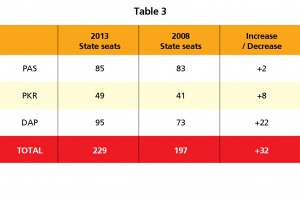 Pakatan also won 32 more state seats in 2013. All three Pakatan parties won more state seats in 2013. Pakatan won 45% of total state seats in 2013 compared to 39% in 2008, a 6% increased. (refer Table 3).
Pakatan also won 32 more state seats in 2013. All three Pakatan parties won more state seats in 2013. Pakatan won 45% of total state seats in 2013 compared to 39% in 2008, a 6% increased. (refer Table 3).
Pakatan’s support increased in 11 out of 13 states and in the Federal Territories including in the Malay majority states of Perlis, Terengganu and Pahang where the % of Malay voters is 70% and higher. (refer Table 4)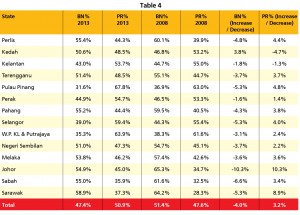
Notes: Calculations made based on valid votes only, Sabah includes Labuan. Change in BN may not equal change in PR for some states because of the presence of independent and non-BN & non-PR candidates
Some of the Malay seats
There are 23 Malay majority (Malay% > 50%) parliamentary seats where PR increased its support by 5% or more from 2008 to 2013. This increase in support could not have been possible if there wasn’t increased support from the Malay voters who form the majority of voters.
For example, in P2 Kangar which is a 80.7% Malay seat, PR increased its support by 16.1%. Similarly, in P41 Kepala Batas, which is a 76% Malay seat, PR increased its support by 11.8%, could not have happened without increased support from the Malay voters.
The reason why not much attention has been paid to these seats is because although PR made significant gains in these seats, they did not win these seats. (refer Table 5)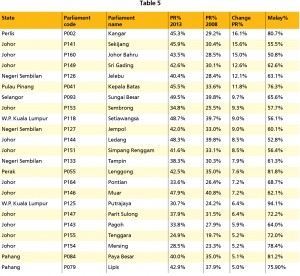
There are 8 Malay majority (>50% Malay) state seats in Selangor where Pakatan’s support increased by more than 5%. This includes 4 state seats which were won by PAS which it did not win in 2008 – namely Tanjong Sepat, Taman Templer, Dusun Tua and Paya Jaras. PAS could not win these seats merely based on an increase in Chinese support. Malay support must also have increased in these Malay majority seats. (refer Table 6)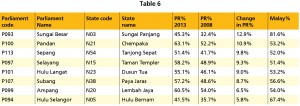

For the first in the nation’s history, Malaysians have a viable choice to Barisan Nasional in the form of Pakatan Rakyat.
There were marked increase Malay support in P102 Serdang for DAP / Pakatan, especially among younger Malays. In the P102.Serdang, using saluran or polling stream data, the Malay support for DAP / Pakatan increased from 36% in 2008 to 43% in 2013.
In the polling stations of the 66% Malay majority of N26 Bangi, the majority for DAP / Pakatan increased from 1,094 in 2008 to 5,825 in 2013. There is also encouraging evidence that younger Malay voters are supporting DAP / Pakatan at higher rates compared to older Malay voters.
Table 7 data shows the difference between the support for the DAP in the oldest saluran (Saluran 1) versus the youngest saluran (Saluran 4, 5 or 6) in the Malay majority polling stations in N26 Bangi. The support for the DAP / Pakatan is clearly and significantly higher among younger Malay voters compared to the older Malay voters.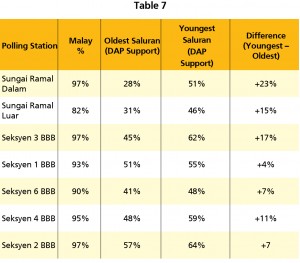
Change in Sarawak too
BN experienced a fall in support of more than 10% from 2008 to 2013 in 8 of the Dayak majority / plurality parliament seats. But this was not sufficient for PR to win any of these seats although PR came closest in P205 Saratok (2081) and P220 Baram (194). (refer Table 8)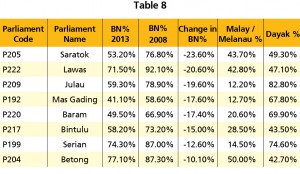
The failure to resolve some serious local problems e.g. land grabs and dam buildings will further erode BN’s support in these areas in the future.
Rising dawn in Sabah
BN experienced a fall of more than 10% in 7 Sabah Bumiputera seats. However, PR only managed to win one of these seats (P174 Penampang). PR came closest in Beaufort, losing by 673 votes.
The BN won 4 parliament seats – P168 Kota Marudu, P180 Keningau, P181 Tenom and P182 Pensiangan – with less than 50% of the vote. (refer Table 9)

Ong with Serdang folks after his victory. He won with a 68% vote margin, a record for DAP in the seat.
Multiple corner fights in these as well as other seats involving STAR and SAPP affected the chances for PR to win more parliament as well as state seats.
At the state level, PR managed to win 11 seats, 6 of which were in non-Chinese majority / plurality areas.
If multiple corner fights can be avoided in the future, PR can build on its current representation of 3 MPs and 11 ADUNs to make further inroads into Sabah.
Beware of gerrymandering
BN has to defend 46 marginal seats compared to 30 for PR in the next election. (refer Table 10)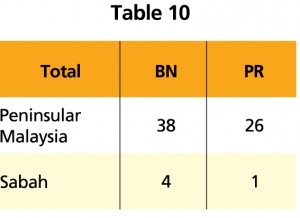
Number of marginal seats (Note – BN or PR win by 55% of vote or less)
It cannot be denied that the BN is on the defensive even though PR did not manage to win a majority of seats.
With an increased number of state seats, especially in the frontline states of Johor, Sabah and Sarawak and with a significant decrease in the level of BN support in these states, the BN cannot consider these states as fixed deposits any longer.
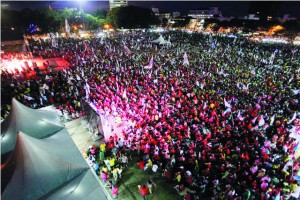
Tens of thousands came out for Pakatan Rakyat’s ceramahs across the country during the campaign period.
Also, with the increase in the number and percentage of younger voters who are less influenced by mainstream media and more willing to vote across racial lines in support of Pakatan, it is increasingly clear that the BN will likely lose power in GE14.
What may save the BN is a grossly skewed and unfair delimitation exercise which is scheduled to start sometime this year and be completed before GE14.








Pingback: A Malaysian Tsunami | PR